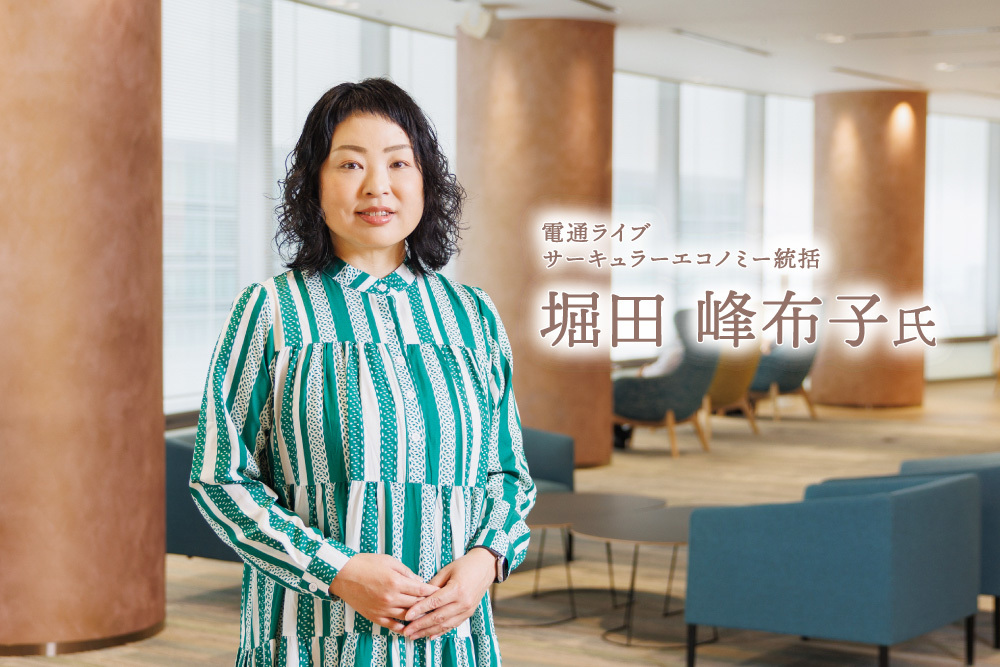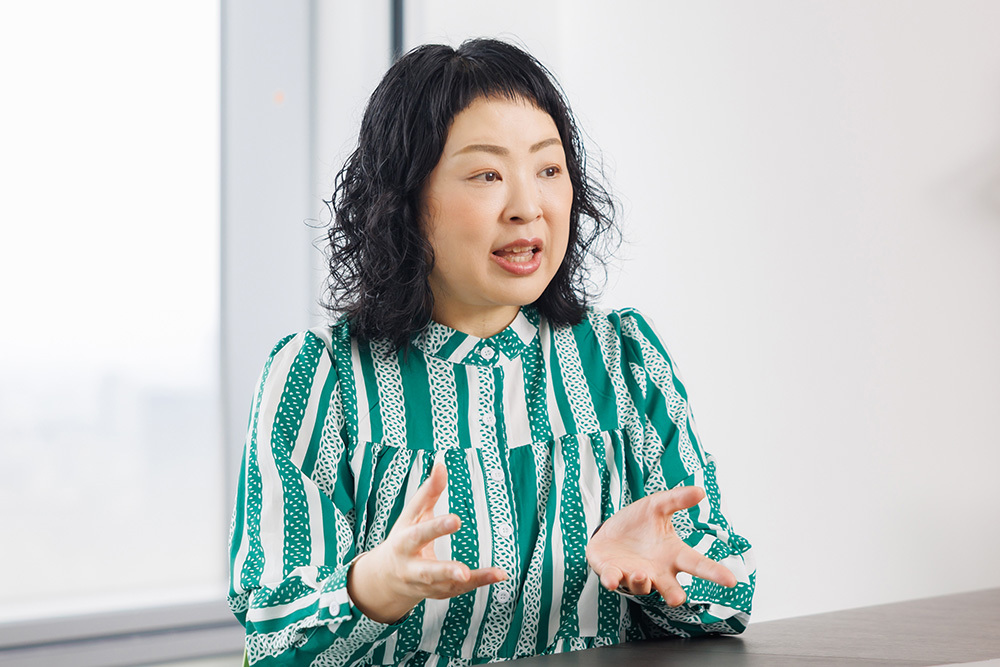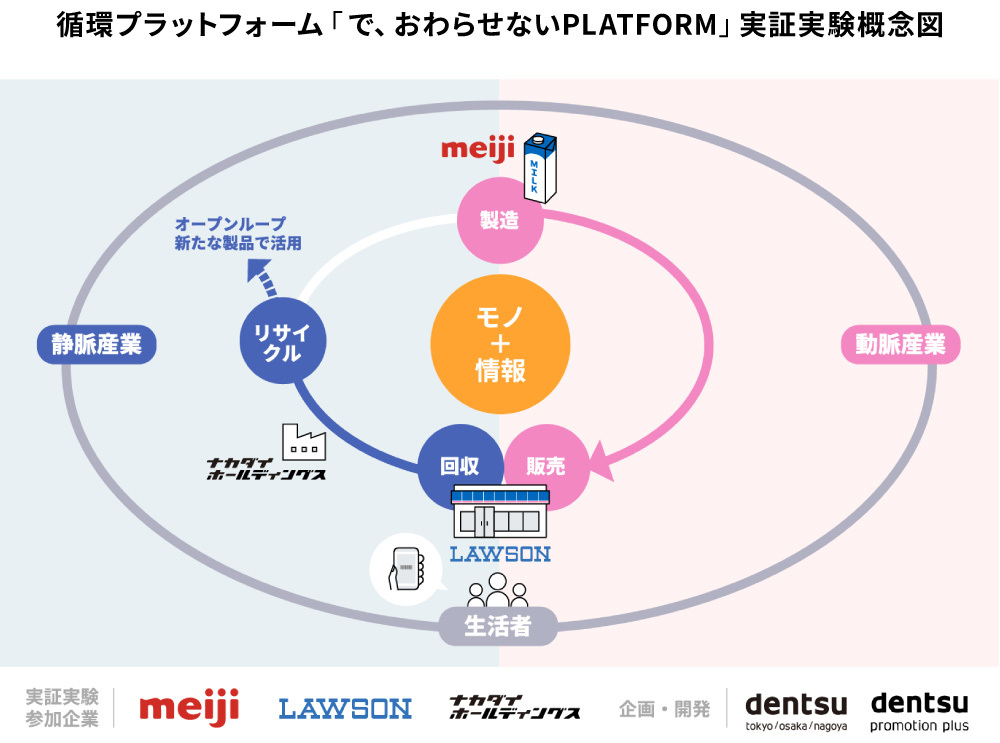Dentsu Live Inc. is Japan's largest event and space specialist company. It plans and operates diverse events, both physical and virtual, and also handles spatial design.
This series explores Dentsu Live Inc.'s "Business Transformation (BX) Utilizing Experience Design." It examines the potential of treating event operations—often positioned merely as "promotion"—as one approach to BX and leveraging that perspective.
Each article features a highly specialized member of Dentsu Live Inc., sharing new possibilities for "events" in business through practical examples.
This time, we speak with Mineko Hotta, Head of Circular Economy. She shares insights using examples from a resource circulation platform pilot project she led.
What Dentsu Live Inc. provides is the value of 'experience design'.
──First, please introduce yourself.
Hotta: I oversee Circular Economy at Dentsu Live Inc. As a circular economy specialist, I plan and operate various circular businesses.
You might wonder why Dentsu Live Inc. has a circular economy expert. In fact, the event industry is uniquely positioned to benefit from the circular economy. Its planned economy nature, where schedules, equipment, and waste are predetermined, offers advantages over other industries for planning, executing, and measuring the effects of circular economy initiatives. Furthermore, we believe moving away from the traditional one-time model of "procurement → production → setup → dismantling → disposal" and adopting a circular economy can create environmental, economic, and social value.
──Please tell us about Dentsu Live Inc.'s business.
Hotta: We are Japan's largest specialized event and space company. Our event business spans a wide range, from large-scale physical events mobilizing many people—such as mobility shows, sports tournaments, exhibitions, and grand opening events for major commercial facilities—to the virtual domain. Our space business encompasses diverse areas including corporate museums, vehicle design, displays, and pop-up stores. Our company employs numerous professionals with specialized knowledge and skills, including licensed architects and first-class construction management engineers, who deliver new experiences to society.
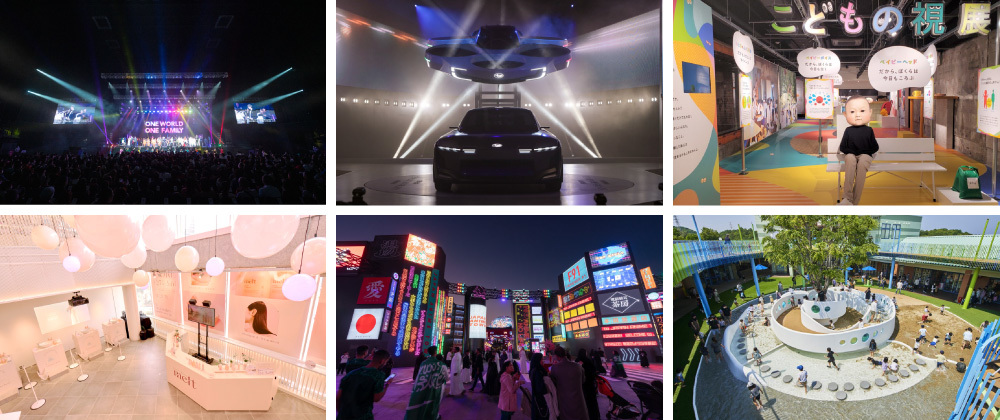
(Top row, from left) True Colors Festival THE CONCERT 2022, SUBARU JAPAN MOBILITY SHOW 2023, Children's Vision Exhibition; (Bottom row, from left) Hara Kado de melt, Japan Anime Town, Park Place Oita Shangri-La Renovation Planning & Design (From Dentsu Live Inc. website)
Hotta: While many people recognize Dentsu Live Inc. as a company in the event and space domain, I see it as a company focused on the overarching concept of "experience design."
──What exactly is experience design?
Hotta: It involves comprehensively designing the value, emotions, and memories users gain throughout every process of interacting with a product or service, thereby promoting multifaceted changes in user awareness and behavior.
In business, events are typically positioned at the final stage of product/service development, serving a promotional role to launch the product into the market. However, by viewing events as "experience design," we believe they can be strategically integrated into upstream development phases and leveraged for BX (Brand Experience). For example, "experience design" can be incorporated into the "testing and validation phase" of new business or product/service development.
In the product development process, even when development proceeds based on user insights and market research results, once the completed product or service is actually launched into the market, consumers may not perceive it as the company intended, or the targeted customer segment may not be acquired. To prevent such gaps, "experience design" can be effectively utilized during the "testing and verification phase."
──What does utilizing "experience design" in the "testing and verification phase" entail?
Hotta: In short, it's real-world experiential test marketing. It involves creating more authentic experience opportunities throughout the entire customer journey to verify how the product or service is presented, and to whom. By feeding the results back into development, it becomes possible to capture the targeted customer segment and enhance engagement when launching new ventures, products, or services.
Even more crucial is the high-quality behavioral and attitudinal change data obtainable through "experience design." The "Testing and Validation Phase" captures actual customer behavior patterns and emotional data unattainable through traditional market research. This data can contribute to building data-driven BX (Brand Experience) strategies that are directly applicable when launching the actual product. Moreover, "experience design + data acquisition and utilization" should also enable the visualization of contributions to mROI (Marketing Return on Investment).
Experience Design in the Resource Circulation Platform "Don't Let It End Here PLATFORM"
──Please share an example of incorporating "Experience Design" into the "Testing and Verification Phase."
Hotta: The Dentsu Group conducted a two-month proof-of-concept experiment for the "Don't Let It End Here PLATFORM" from December 2023 to January 2024 ( release here ). The "Don't Let It End Here PLATFORM" is a circular economy initiative that digitally connects the "arteries" of manufacturing and distribution companies, the "veins" of recyclers, and consumers.
Hotta: For the pilot, we collaborated with Meiji, Lawson, and Nakadai Holdings to build an "experience design" combining "collection and recycling" of empty containers with "promotional incentives" like coupons and points. Consumers deposit paper-packaged products sold at Lawson stores, including "Meiji Oishii Milk," into resource recycling boxes installed at Lawson stores. When depositing, scanning the paper pack's JAN code allows them to obtain a coupon for "Meiji Oishii Milk."
──So you built an "experience design" that actually allows consumers to participate in collection and recycling actions. What insights did you gain?
Hotta: The pilot test allowed us to collect and analyze data on participants' behavioral changes in awareness. This enabled us to create a foundational model applicable to future circular economy initiatives. We also uncovered several interesting findings.
Modeling the Conversion Rate from Awareness to Action
We identified a concrete conversion rate: when awareness of collection activities is 100%, the final collection completion rate ranges from 5% to 10%. This enables the development of specific countermeasures against drop-off factors at each stage of customer collection—a key challenge in the circular economy (*).
※Estimated based on actual results from general closed campaigns and the Dentsu Group proof-of-concept experiment
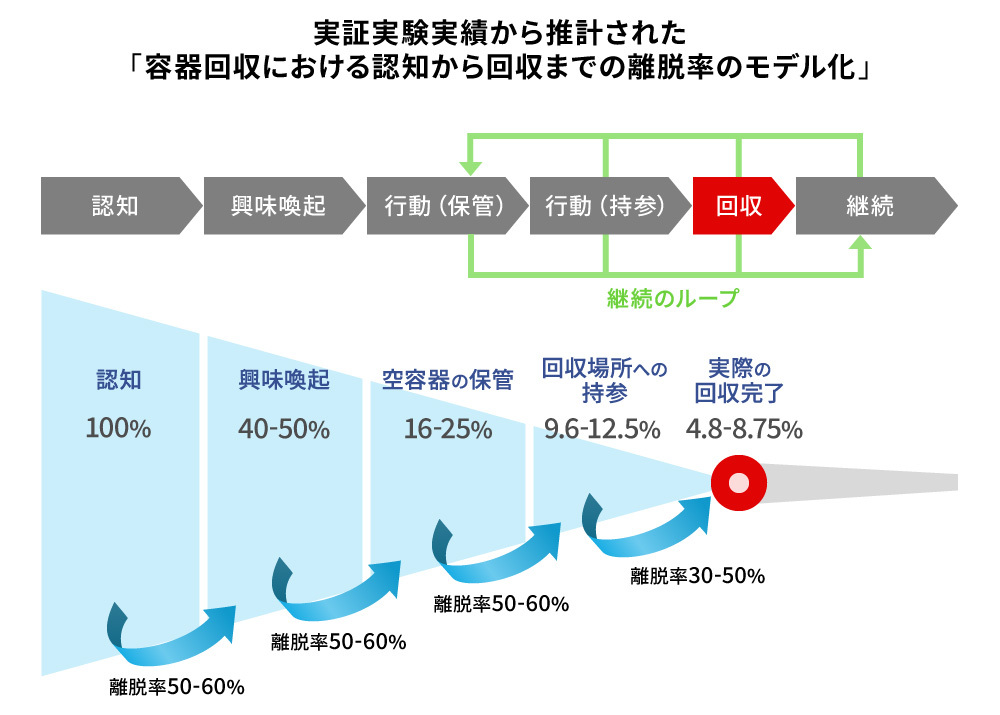
Visualizing Consumer Behavior Patterns
Initially, we hypothesized that bringing items to collection points would have the highest drop-off rate. However, we discovered that the storage phase for empty containers is also a major drop-off factor. The pilot revealed a consumer behavior pattern: consumers store several empty boxes at home and bring them to stores once they accumulate. While this may seem obvious, the finding highlights that without dedicated storage space at home, storing empty boxes or containers becomes cumbersome, making consumers more likely to drop out of the collection process. This suggests that when operating collection initiatives, providing storage bags or boxes should also be considered.
Behavioral Change Rate by Customer Segment
We segmented customers who participated in the pilot program and analyzed their behavioral change rates. Comparing the behavioral change rate—the percentage of participants who had never participated in collection before but did so because of this initiative—we found a significant difference: 5.9% for loyal customers of "Meiji Oishii Milk" versus 2.8% for non-loyal customers. This indicates that loyal customers who previously did not participate in collection are more likely to change their behavior if collection points are nearby. Therefore, targeting loyal customers was seen to contribute to both sustained purchasing and collection, supporting the dual goals of business viability and social contribution.
Additionally, the pilot test yielded various data points: changes in store visitor numbers, participation in collection activities, participation frequency, contribution to sales, and the impact of initiatives on brand image. We believe that conducting this pilot test in physical stores as real-experience test marketing enabled us to provide authentic experiential design and capture detailed insights into consumer awareness and behavioral changes through the fusion of "offline × digital."
──By incorporating "experience design" into the "Testing and Verification Phase," we found we could collect diverse data and grasp consumer behavior models.
Hotta: The Dentsu Group includes companies strong in data, such as the Data Technology Center, Dentsu Digital Inc., and Dentsu Macromill Insight, Inc. These companies can collaborate with Dentsu Live Inc., which aggregates insights into human subtleties and movements. For example, by utilizing IoT, eye-tracking (gaze measurement technology), and physiological response measurement within "experience design," we can quantitatively analyze participants' emotional and behavioral data, enabling highly accurate marketing.
Beyond the proof-of-concept experiments introduced here, building experience design and acquiring/utilizing data can enhance the precision of new ventures, products, and services.
This series will continue to introduce Dentsu Live Inc.'s initiatives, which drive business transformation by flexibly integrating the comprehensive experiential value cultivated in the event domain into business operations.


